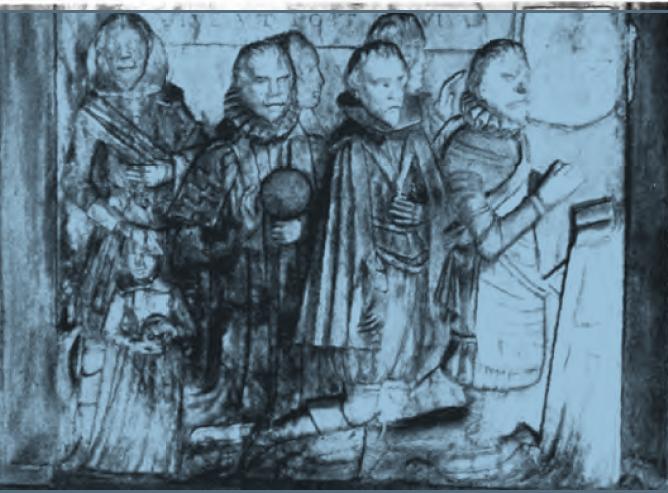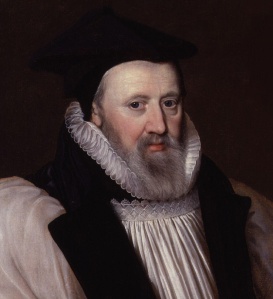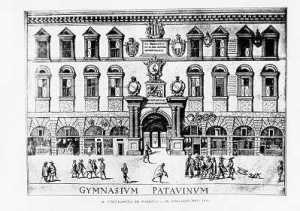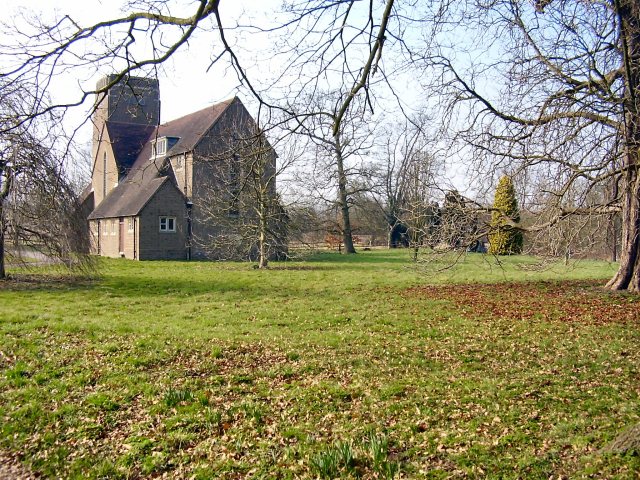I’ve decided to write something here about my (probable) ancestor Bartholomew Fowle, who was the prior of St Mary Overy, Southwark, at the time of the dissolution of the monasteries, even though he was not strictly speaking a recusant – a term that would only really come into use during the reign of Elizabeth I. However, like countless other faithful Catholics, Bartholomew’s world was turned upside down by the seismic upheavals of the Reformation. Moreover, telling Bartholomew’s story seems like a natural sequel to the last post about my 12 x great grandfather Magnus Fowle and his recusant connections. As with my that post, I’ll be drawing on my own original genealogical research, some of which I’ve already published on my family history blog Past Lives.

St Mary Overy, from John Norden’s map of London (c.1593)
Origins
If some sources are to be believed, Bartholomew Fowle was Magnus Fowle’s uncle, the brother of his father Gabriel, who was my 13 x great grandfather. Gabriel Fowle was the master of the Free Grammar School in Lewes, Sussex, which historically had been linked to the Priory of St Pancras, until the latter’s dissolution and destruction in 1537 by Thomas Cromwell. Gabriel died in 1555, during the brief restoration of Catholicism under Queen Mary, and his will is evidence of his loyalty to the old faith, requesting ‘x [ten] preistes yf they can be gott to celebrate & say masse for my sowlle & all crysten sowles’ and leaving ‘my wrytten masse book’ to his parish church in Southover, Lewes.
Gabriel and Bartholomew were supposedly the sons of Nicholas Fowle of Lamberhurst, Kent, who died in 1522, but there is no mention of Bartholomew in Nicholas’ will. This, and the fact that Bartholomew was also known as Bartholomew Linsted or Lynsted, apparently because he came from the village of that name, also in Kent but some thirty miles from Lamberhurst, lead me to cast doubt on the tradition that he was Gabriel’s brother. It seems more likely that he might have been Nicholas Fowle’s brother, and therefore Gabriel’s uncle. However, there is some evidence pointing to Bartholomew’s connection with the family. When another Fowle brother, Thomas, made his will in 1525, he asked to be buried in the church of St Margaret, Southwark, to which he also bequeathed money, despite the fact that his home was in Lamberhurst. St Margaret’s belonged to the priory of St Mary Overy, Southwark, of which Bartholomew Fowle was then prior. Thomas also left money to his ‘ghostly’ – i.e. spiritual – father: might this have been Bartholomew?
One of the sources of information about Bartholomew Fowle’s birth is the chapter on Lynsted in an eighteenth-century history of Kent, which notes that ‘Bartholomew Fowle, alias Linsted, a native of this place, was the last prior of St Mary Overie, London, being elected to that office anno 1513.’ Interestingly, Lynsted was also closely associated with the Roper family, who were linked by marriage with Sir Thomas More: I’ve written before about the recusant Lady Roper of Teynham who lived at Lynsted Lodge in the early seventeenth century.
Some sources give Bartholomew’s name as Lynsted alias Fowle, while others reverse the order. We can only speculate as to why Bartholomew used an alternative surname. Was it a common habit to take the name of your home village, or was it a particular practice among members of religious orders? Did Bartholomew find it politic to conceal his Fowle family connections for some reason, or alternatively did he have a particular reason (a local benefactor or sponsor, for example) for identifying with Lynsted?

Lynsted Lodge, Kent
Leeds Priory
Bartholomew Fowle joined the Canons Regular at the Augustinian priory of St Mary and St Nicholas at Leeds, Kent, about twelve miles south-west of Lynsted and eighteen miles north-east of Lamberhurst, which happened to be one of the manors it owned and one of the parishes for which it possessed the advowson .
Canons Regular were priests living in community under the Rule of St Augustine and sharing their property in common. Unlike monks, who lived a cloistered, contemplative life, the purpose of the life of a canon was to engage in a public ministry of liturgy and sacraments for those who visited their churches. Apparently the canons sought to reflect supernatural order and stability within their priories, with examples of worship, farming, medical care, librarianship, learning, and so forth. The canons often worked in towns and cities, where the worship, medicines, education and the skills of the enclosed Benedictines were not present to the growing numbers of urban dwellers. By the twelfth century hundreds of communities of canons had sprung up in Western Europe. Usually they were quite autonomous of one another, and varied in their ministries.
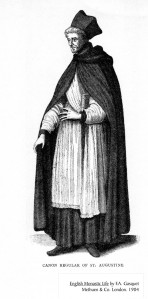
Augustinian canon
I’m not sure at what age young men and women joined religious orders at that time, but my research into recusant families suggests that it was usually in their middle teens. Even so, this doesn’t help us with determining Bartholomew’s date of birth, since although we know when he left Leeds priory – 1509 – we don’t know when he joined. I haven’t found any records for Leeds priory during Bartholomew’s time there, but two years after he left, Archbishop Warham of Canterbury made a visitation. According to a county history:
Richard Chetham, prior, said that all was well; John Bredgar, formerly prior, was now vicar of Marden, and rarely came to the monastery, but thought that all things were well; and Thomas Vincent, sub-prior, said that much had been reformed, but much still remained to be reformed by the prior and sub-prior. […] Besides the eight canons already named there were twelve others, making a total of twenty in addition to the prior.
St Mary Overy
Bartholomew Fowle transferred from Leeds to the priory of St Mary Overy at Southwark in 1509, the year in which Henry VIII came to the throne. Presumably this was a promotion of some kind, but if so, it wasn’t yet to a senior role in the community, since that would not come until 1513, four years after Bartholomew’s arrival in Southwark. According to one source, Bartholomew Lynsted alias Fowle was elected sub-prior in January 1513, but there is a suggestion that he was promoted again to prior very soon afterwards, perhaps as early as February in the same year. Robert Michell had been prior from 1499 until his resignation in 1512, when he was succeeded by Robert Shouldham, whose term of office appears to have been less than a year.
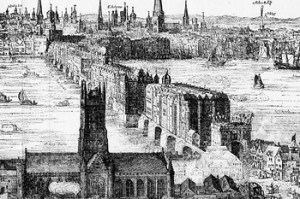
Southwark church and London Bridge in 1616
According to oral tradition, there had been a church in Southwark, just south of London Bridge, since before the Norman Conquest. In the early twelfth century it was re-founded as an Augustinian priory, dedicated to St Mary, and became known as St Mary Overy (‘over the river’). The canons created a hospital alongside the church, the direct predecessor of St Thomas’ Hospital and originally named in honour of the martyr St Thomas à Beckett.
We know very little about Bartholomew’s time as prior of Southwark, which coincided with the tumultuous years of Henry VIII’s reign. We do know that he was present at an important chapter of the Augustinians in Leicester, on Monday, 16 June, 1518, when one hundred and seventy 1 joined in the procession, of whom thirty-six were prelati or heads of houses. According to one account:
As night came on they adjourned till Tuesday morning at seven, and when they again assembled, the prior of Southwark, with every outward demonstration of trouble and sorrow, appealed for a stricter and verbal observance of their rule. His manner and address excited much stir, but he was replied to by many, particularly by the prior of Merton. On the first day of this chapter a letter had been read from Cardinal Wolsey observing with regret that so few men of that religion applied themselves to study. On Wednesday, the concluding day of the chapter, Henry VIII and his then queen were received into the order.
Sources claim that Bartholomew Fowle was ‘a very learned man’, and not just in matters of religion. He was the author of the book De Ponte Londini in which he popularised a tradition about the origins of London Bridge, subsequently repeated in Stow’s Survey of London. According to one source:
In the early part of the Saxon times there is no notice of any town or other place on this spot ; but a tradition of Bartholomew Linsted, or Fowle, Iast prior of St. Mary Overie, preserved by Stow (Survey of London, book i, chapter xiii), notices that the profits of the ferry were devoted by the owner, “a maiden named Mary,” to the foundation and endowment of a nunnery, or “house of sisters,” afterwards converted into a college of priests, by whom a bridge of timber was built, which with the aid of the citizens was afterwards converted into one of stone.
In 1535 the annual value of Southwark priory was declared to be £624 6s. 6d, with its rents in Southwark alone realising £283 4s. 6d. On November 11th of that year there was a great procession by command of the king, at which the canons were present, with their crosses, candlesticks, and vergers before them, all singing the litany. However, if this was a sign of royal favour towards St Mary Overy, it was to prove shortlived.
Dissolution
In 1531, following the dispute with Rome over his plan to divorce Queen Katharine, Henry VIII had declared himself Supreme Head of the Church of England. Five years later the king, through the agency of his chief enforcer Thomas Cromwell, began the process of suppressing the country’s religious houses and appropriating their property. According to Wriostheley’s Chronicle for the year 1539:
Also this yeare, in Octobre, the priories of Sainct Marie Overis, in Southwarke, and Sainct Bartholomewes, in Smithfield, was suppressed into the Kinges handes, and the channons putt out, and changed to seculer priestes, and all the landes and goodes [escheated] to the Kinges use.
The priory of St Mary Overy was ‘surrendered’ to Thomas Cromwell’s agents on 27th October 1539. Cromwell himself signed the pension list, which granted £8 each per annum to two of the canons and £6 to nine others. There were eleven annuitants in all, besides the prior, with their pensions totalling £70 in all. At least one source claims that Bartholomew Fowle quibbled over his original grant of £80 per annum and managed to have it increased to £100. In addition, Bartholomew was provided with a house ‘within the close where Dr Michell was dwelling’. Robert Michell was the last prior but one before Bartholomew, and had probably resigned due to ill health or old age. (A certain William Michell, almost certainly a relative, had witnessed the will of Thomas Fowle of Lamberhurst in 1525.)

Montague Close, Southwark
In 1545 the priory buildings and grounds came into the possession of Sir Anthony Browne, and there were complaints in the manor court of Southwark that he had opened a public bowling green in the close and was allowing gambling there. Although he was a staunch Catholic, Browne remained a close friend of Henry VIII and became the owner of a great deal of former monastic property. His eldest son, another Anthony, was created Viscount Montague in the time of Queen Mary. It seems probable that Lord Montague lived in what had previously been the house of the prior of St. Mary Overy and utilised the other buildings for stabling and so forth. He died in 1593, leaving to his wife, Magdalen, his mansion house of ‘St. Mary Overies,’ for her life, with reversion to his grandson Anthony.
The area around the former priory buildings became known as Montague Close and, as I’ve noted before, it would become a notorious refuge for Catholic recusants, under the protection of the Browne family.
Later life
There is evidence that Bartholomew Fowle remained in London after his enforced retirement, and also that he continued to serve as a priest. For example, in 1543 Dame Joan Milbourne, the widow of a former lord mayor of London, bequeathed money in her will to a number of priests to come to her burial at the church of St Edmund, Lombard Street, and to pray for her. She left the sum of £6 13s 6d ‘to my very good friend Bartholomew Linsted some time prior of St Mary Overies, to pray for my soul’. From this, we can conclude two things: firstly, that Bartholomew Fowle was well connected with the gentry of London, and secondly that, despite the religious changes of Henry’s reign, Catholic practices such as prayers for the dead remained popular.
The date of Bartholomew’s death is unknown, and I’ve failed to find any trace of a will, but a number of sources confirm that he was still receiving his pension in 1553. In other words, he lived for at least another fifteen years or so after his expulsion from St Mary Overy. This means that, like my ancestor and his relative Gabriel Fowle, Bartholomew may have lived long enough to have his hopes revived by the brief restoration of Catholicism under Queen Mary.

Nave of Southwark Cathedral (Anglican)
As for St Mary Overy, in time the priory church would be renamed as St Saviour’s (my 9 x great grandparents, Magnus Byne, rector of Clayton-cum-Keymer and Anne Wane, were married there in 1640), before becoming the Anglican Cathedral of Southwark in 1905. A Catholic cathedral – St George’s – was dedicated in Southwark in 1848.
